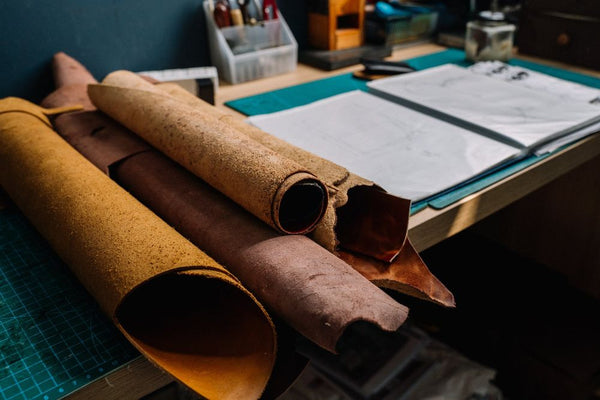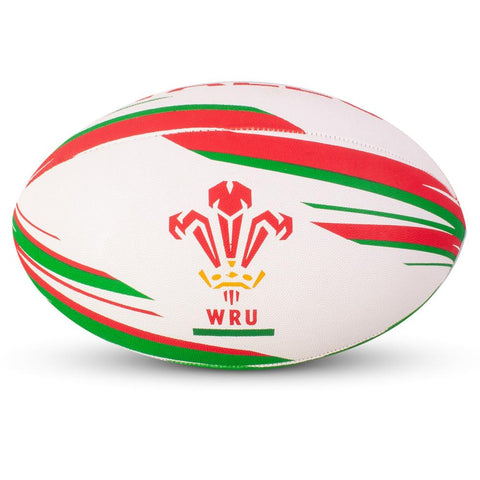What Are Rugby Balls Made of?
If you’re wondering “What are rugby balls made of?” you’ve landed on the right page. In this guide, we’ll delve into what makes a rugby ball more than just a piece of sports equipment.
We’ll discuss rugby ball construction, uncovering the materials and methods that transform simple components into an icon of athleticism and teamwork.
At UK Rugby Store, we not only sell a range of rugby balls but also share a passion for understanding every aspect of their design and function.
Our range includes various options, including the Ireland RFU Rugby Ball, Scotland RU Rugby Ball, Wales RU Rugby Ball, and England RFU Rugby Ball - all exemplifying top-notch craftsmanship.
Let’s dig deeper into the intricacies of what makes up the legendary rugby ball.
What this article covers:
- What Is a Rugby Ball Made of?
- How Are Rugby Balls Made?
- Size Guide to Rugby Balls
- History of Rugby Balls
What Is a Rugby Ball Made of?
Materials
Historically made from pig bladders and leather, rugby balls have evolved significantly. Modern rugby balls, as we provide at UK Rugby Store, are crafted from a blend of synthetic materials.
These include rubber, synthetic leather, and sometimes a mix of cotton and polyester layers for added durability and performance. The synthetic leather surface provides the essential grip, while the rubber content ensures the ball is weather-resistant and maintains its shape.
This evolution from the natural to the synthetic has been crucial in enhancing the ball's performance, especially in varying weather conditions.

Construction
Panel Construction
The panel construction of a rugby ball is critical to its performance. A standard rugby ball, like those available at our store, comprises four panels. These panels are stitched together, providing the iconic oval shape.
The stitching method and the panel shape contribute significantly to the ball's aerodynamics, affecting its flight and how it moves through the air. The precise construction of these panels plays a vital role in the ball's overall quality and usability.
Bladder
At the heart of every rugby ball is the bladder, which is responsible for retaining air and giving the ball its firmness. Modern rugby balls use synthetic bladders, often made from latex or butyl.
These materials are chosen for their ability to hold air for extended periods, ensuring that the ball maintains consistent pressure and shape during play. The bladder's quality directly impacts the ball's performance, affecting everything from its bounce to its flight.
Grip
The grip of a rugby ball is a defining feature, crucial for players to handle the ball effectively, especially in wet conditions. The textured surface on the synthetic leather of the ball provides this necessary grip.
This texture varies across different models and brands, with some offering a more pronounced grip pattern than others. The grip technology has evolved to ensure maximum control, a feature we prioritize in our selection at UK Rugby Store.

Valve Shape And Placement
Lastly, the valve of the rugby ball, although a small component, plays a significant role in the ball's performance. The valve's shape and placement can affect how the ball spins and moves in the air.
Typically, the valve is placed at the ball's seam to ensure it does not interfere with the grip or the flight path. The valve's design is an integral part of the ball's overall engineering, ensuring balanced inflation and contributing to the ball's aerodynamic properties.
How Are Rugby Balls Made?
Rugby balls are not just a fundamental component of one of the world's most popular sports; they are marvels of modern engineering and craftsmanship. Making a rugby ball involves intricate steps, combining traditional techniques with advanced materials.
Material Selection
The journey of creating a rugby ball begins with selecting suitable materials. As discussed, modern rugby balls are predominantly made from synthetic materials, a shift from traditional leather to accommodate better durability and performance.
The primary material used is synthetic leather, often polyurethane or PVC, chosen for its ability to withstand harsh playing conditions and its waterproof qualities. This material also provides the necessary grip for players.

Panel Cutting And Stitching
Once the materials are chosen, they are cut into panels. A standard rugby ball consists of four panels, which are then stitched together. Precision cutting and stitching these panels are crucial as they affect the ball's shape and aerodynamics.
Initially, these panels are stitched inside out, and later, the ball is inverted to hide the stitches, contributing to the ball’s smooth exterior.
Bladder Insertion And Inflation
After the outer shell is prepared, the bladder is inserted into the ball. This step is critical as the bladder must be perfectly centered to balance the ball.
Once inserted, the bladder is inflated to the correct pressure. This pressure is meticulously monitored as it significantly influences how the ball behaves during a game.
Quality Control And Finishing Touches
Quality control is an integral part of the manufacturing process. Each ball, including specialized products like the England RFU Rugby Ball, is checked for its weight, balance, and shape. Only those that meet strict standards make it to the next stage.
After passing quality control, the balls are branded with logos and designs. This branding is not just for aesthetics; it often includes textures to enhance grip and control, further exemplified in the carefully crafted designs on balls such as the Wales RFU Rugby Ball.
The evolution of rugby ball manufacturing reflects technological advancements and a deeper understanding of the sport's needs. Innovations in materials and design have led to balls that are more durable, easier to grip, and suitable for various weather conditions.
Using modern synthetic materials ensures that the balls are consistent in quality, providing a reliable experience for players at all levels.
The making of a rugby ball is a blend of art and science. Each ball is a product of careful material selection, precise craftsmanship, and stringent quality control, ensuring it meets the high demands of a fast-paced and physically demanding sport like rugby.
Size Guide to Rugby Balls
Choosing the right size rugby ball is crucial for the player's development and enjoyment of the game. Rugby balls come in various sizes, ranging from size 3 for young children to size 5 for adults and professional players.
Size 4 balls are typically used by players aged 10-14. Each size is designed to fit the hand size and strength of the players in the respective age group.

History of Rugby Balls
Who Invented The Rugby Ball?
The origins of the rugby ball trace back to the game's early days in the 19th century. The first rugby balls were made by William Gilbert, a shoemaker in Rugby, England, where the sport originated.
Initially, these balls were made from pig bladders, encased in leather, and took on a more plum-like shape. Over the years, the design and materials have evolved, but Gilbert's legacy lives on in the rugby balls we use today, including those available at UK Rugby Store.
Why Is A Rugby Ball Oval?
The distinct oval shape of the rugby ball is a result of its historical design and the practical needs of the game. Initially shaped by the natural form of a pig's bladder, the ball's design was refined over time to aid in carrying and passing.
The oval shape allows players to hold and control the ball more easily, especially when running at high speeds or in wet conditions. It also impacts the ball's aerodynamics, allowing for various kicks and throws.
Conclusion
In this article, we've explored the composition, construction, material, and history of the rugby ball, a central element of this thrilling sport.
From the selection of materials to the intricate stitching process, every aspect of a rugby ball is designed to enhance performance and durability.
The evolution of its design, from the early plum-shaped balls to the modern synthetic versions, reflects the dynamic nature of rugby itself.
At UK Rugby Store, we invite you to experience the quality and history embedded in each ball we offer.
Whether you're a seasoned player or a passionate fan, we encourage you to shop our collection of high-quality, official merchandise for the world's leading clubs and international rugby teams.
Embrace the spirit of rugby with the best apparel supplier in the game!
If you want to learn more, why not check out these articles below:





